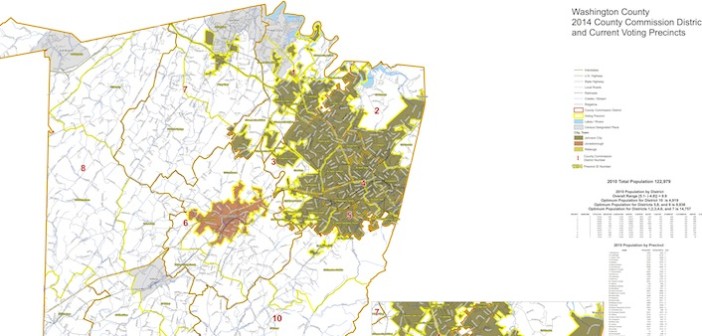By Scott Robertson
The Washington County Commission will be asked at its April 27 meeting to consider cutting its size from 25 members to 15, effective at the next commission elections. That recommendation will be made by the Reapportionment Committee, which voted 9-1 at its April 2 meeting in favor of doing so.
The committee, the only job of which is to considering possible cuts to the size of the County Commission and related redistricting issues had, at its March meeting, asked Chris Pape, county GIS expert, to return for the April meeting with several sample maps showing how the county would be redistricted under different scenarios.
Joe Grandy, committee chair, said the maps considered at the April meeting were not final by any means. “The options we looked at were just sort of an indoctrination for the committee to see what the mapping system capabilities are.”
The committee had asked Pape to bring back maps of what the county would look like with representation plans as small as nine districts with one commissioner each to 10 districts with two commissioners each.
By state law, every commissioner must represent as close to the same number of county residents as every other. Thus, under the current system, in which some districts have three commissioners and one district has only one commissioner, the districts with more commissioners have greater representation on the commission. If a district with one commissioner has only 5,000 people and a district with three commissioners has 15,000, the representation per commissioner is the same 5,000-to-1 ratio, but the representation for the larger district is three times that of the smaller district when the commission votes.
“That was a real eye-opening component of this for some commissioners,” Grandy said. “That was a great rationale having just one commissioner per district.”
Commissioner Robbie Tester put forward the idea of having two commissioners in each district, so if there were to be a ”bad commissioner,” the other commissioner in that district could at least “even things out.” That idea failed to gain any traction with other commissioners.
One factor the state of Tennessee mandates be a key part of the reapportionment process is that the difference between the sizes of the districts, in terms of population, shrink. In other words, each commissioner should come closer to representing the same number of county residents as every other commissioner at the end of the process than he or she did at the start.
“Well, for instance,” Grandy said, “we are at the maximum deviation allowed right now, which is 10 percent. The largest spread, between the commissioner who represents the most people and the commissioner who represents the least is about 1,500 people.” Under the plans put forth by Pape in his preliminary maps, the highest deviation is only 3.8 percent.
Should the commission vote to accept the committee’s recommendation, cost savings could begin to accrue as soon as the next commission election, Grandy said. Not only will the costs accrued by commissioners for expenses drop by 40 percent, the cost of elections in the county could drop significantly as well, Grandy said.
“One of our goals will be to build the new commission districts as closely along the lines of the state representative districts as possible. This will allow the election commission the opportunity, should they take it, to streamline the election process, cutting the number of precincts that vote in the county.”
The county commission and its committees have no say in that, Grandy said, but, he added, “we can certainly set up the districts to give them that opportunity. We had precincts in the last election that voted fewer than 100 people.”






